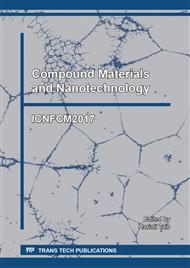[1]
L. Wiemes, U. Pawlowsky, V. Mymrin, Incorporation of industrial wastes as raw materials in brick's formulation, J. Clean. Prod. 142 (2017) 69-77.
DOI: 10.1016/j.jclepro.2016.06.174
Google Scholar
[2]
H.B. Wang, L.X. Ma, L. Li, B. Zhang, Fabrication of Fe-based bulk metallic glasses from low-purity industrial raw materials, J. Alloy. Compd. 629 (2015) 1-4.
DOI: 10.1016/j.jallcom.2014.11.228
Google Scholar
[3]
A. Harabi, S. Kasrani, L. Foughali, I. Serradj, M.T. Benhassine, S. Kitouni, Effect of TiO2 additions on densification and mechanical properties of new mulltifunction resistant porcelains using economic raw materials, Ceram. Int. 43 (2017).
DOI: 10.1016/j.ceramint.2017.01.081
Google Scholar
[4]
I. Gonzalez, P. Campos, C.B. Brioso, A. Romero, E. Galan, E. Mayoral, A proposal for the formulation of high-quality ceramic green, materials with traditional raw materials mixed with Al-clays, Appl. Clay Sci. 131 (2016) 113-123.
DOI: 10.1016/j.clay.2015.12.035
Google Scholar
[5]
S. Platias, K.I. Vatalis, G. Charalampides, Suitability of quartz sands for different industrial applications, Proc. Econ. Finan. 14 (2014) 491-498.
DOI: 10.1016/s2212-5671(14)00738-2
Google Scholar
[6]
S.F. Wen, Q.W. Shen, Q.S. Wei, C.Z. Yan, W. Zhu, Y.S. Shi, J.S. Yang, Y.S. Shi, Material optimization and post-processing of sand moulds manufactured by the selective laser sintering of binder-coated Al2O3 sands, J. Mater. Proc. Tech. 225 (2015).
DOI: 10.1016/j.jmatprotec.2015.05.028
Google Scholar
[7]
Z.Y. Liu, K. Zhao, B.L. Xiao, W.G. Wang, Z.Y. Ma, Fabrication of CNT/Al composites with low damage to CNTs by a novel solution-assisted wet mixing combined with powder metallurgy processing, Mater. Design. 97 (2016) 424-430.
DOI: 10.1016/j.matdes.2016.02.121
Google Scholar
[8]
V. Gonzalez, S.E. Taylor, Asphaltene adsorption on quartz sand in the presence of pre-adsorbed water, J. Colloid Interf. Sci. 480 (2016) 137-145.
DOI: 10.1016/j.jcis.2016.07.014
Google Scholar
[9]
P. Zhang, J. Huang, Z. Shen, X. Wang, F. Luo, P. Zhang, J. Wang, S.D. Miao, Fired hollow clay bricks manufactured from black cotton soils and natural pozzolans in Kenya, Const. Build. Mater. 141 (2017) 435-441.
DOI: 10.1016/j.conbuildmat.2017.03.018
Google Scholar
[10]
A. Ukwatta, A. Mohajerani, Characterisation of fired-clay bricks incorporating biosolids and the effect of heating rate on properties of bricks, Const. Build. Mater. 142 (2017) 11-22.
DOI: 10.1016/j.conbuildmat.2017.03.047
Google Scholar
[11]
M.F. Zawrah, R.A. Gado, N. Feltin, S. Ducourtieux, L. Devoille, Recycling and utilization assessment of waste fired clay bricks (Grog) with granulated blast-furnace slag for geopolymer production, Process Safety Environ. Prot. 103 (2016) 237-251.
DOI: 10.1016/j.psep.2016.08.001
Google Scholar
[12]
A. Mohajerani, A.A. Kadir, L. Larobina, A practical proposal for solving the world's cigarette butt problem: Recycling in fired clay bricks, Waste Manag. 52 (2016) 228-244.
DOI: 10.1016/j.wasman.2016.03.012
Google Scholar
[13]
L. Han, F.L. Li, X.G. Deng, J.K. Wang, H.J. Zhang, S.W. Zhang, Foam-gelcasting preparation, microstructure and thermal insulation performance of porous diatomite ceramics with hierarchical pore structures, J. Eur. Ceram. Soc. 37 (2017) 2717-2725.
DOI: 10.1016/j.jeurceramsoc.2017.02.032
Google Scholar
[14]
M. Sutcu, S. Ozturk, E. Yalamac, O. Gencel, Effect of olive mill waste addition on the properties of porous fired clay bricks using Taguchi method, J. Environ. Manag. 181 (2016) 185-192.
DOI: 10.1016/j.jenvman.2016.06.023
Google Scholar
[15]
Y. Hangai, N.N. Minh, T. Morita, R. Suzuki, M. Matsubara, S. Koyama, Cutting process for aluminum foam fabricated by sintering and dissolution process, Adv. Powder Tech. 28 (2017) 1426-1429.
DOI: 10.1016/j.apt.2017.02.021
Google Scholar


